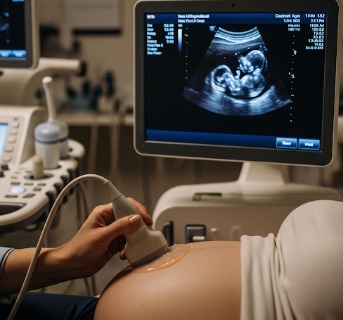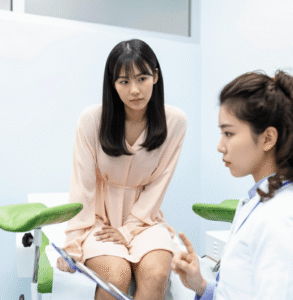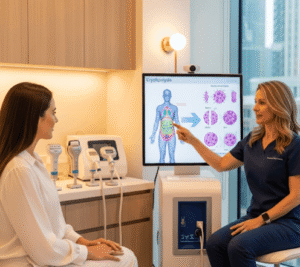Overview
Ultrasound (sonography) is a safe, painless, and widely used medical imaging technique that uses high-frequency sound waves to produce real-time images of the body’s internal organs, blood flow, and tissues. Unlike X-rays or CT scans, ultrasound does not use radiation, making it especially useful for pregnancy monitoring, abdominal examinations, heart evaluations, and musculoskeletal assessments.
South Korea is a global leader in advanced diagnostic imaging, offering cutting-edge ultrasound machines with 3D/4D imaging, Doppler technology, and AI-assisted analysis. Korean hospitals and clinics provide both routine and specialized ultrasound scans with rapid results and highly trained radiologists.
What is Ultrasound?
Ultrasound is a diagnostic test that uses sound waves to create live images of the body’s organs and tissues. A handheld probe called a transducer sends sound waves into the body and records the echoes as they bounce back, creating clear images on a monitor.
Common types of ultrasound include:
- ➤ Abdominal ultrasound – liver, kidneys, gallbladder, pancreas
- ➤ Pelvic ultrasound – uterus, ovaries, prostate, bladder
- ➤ Obstetric ultrasound – monitoring pregnancy and fetal development
- ➤ Cardiac ultrasound (echocardiography) – heart structure and function
- ➤ Vascular ultrasound – arteries, veins, and blood flow
- ➤ Musculoskeletal ultrasound – muscles, ligaments, joints
What are the Benefits?
✔ Non-invasive and painless imaging technique
✔ No radiation exposure – safe for pregnant women and children
✔ Quick results with real-time imaging
✔ Cost-effective compared to CT or MRI
✔ Widely available in Korean hospitals and clinics
✔ Early detection of many diseases and abnormalities
✔ Safe for repeated use in follow-up monitoring
Procedure Details:
1) How should I prepare for Ultrasound?
- ● Fasting requirement: For abdominal scans, patients may need to fast for 6–8 hours to reduce gas and improve visibility.
- ● Full bladder: For pelvic or pregnancy ultrasounds, drinking water beforehand helps create a clearer image.
- ● Clothing: Wear loose, comfortable clothing; in some cases, patients may need to change into a hospital gown.
- ● Korean standard practice: Clinics provide clear pre-test instructions, often with multilingual guidance for international patients.
2) What happens during the procedure Ultrasound?
- ➤ Patient positioning: The patient lies down on an examination table.
- ➤ Gel application: A warm gel is applied to the skin to help sound waves transmit.
- ➤ Probe movement: The technician (sonographer) moves the transducer over the target area.
- ➤ Image capture: The monitor displays real-time images, which the doctor analyzes.
- ➤ Duration: Most scans take 15–45 minutes depending on the body area.
- ➤ Advanced Korean technology: Many hospitals use 3D/4D ultrasound for enhanced visualization, especially in pregnancy and complex conditions.
3) What happens after an Ultrasound?
- ● No recovery time needed – patients can resume normal activities immediately.
- ● Results review: A radiologist reviews the images and sends a report to the physician.
- ● Pregnancy ultrasound: Patients may receive printed or digital images.
- ● Korean patient care advantage: Reports are usually available on the same day, often with consultation to explain findings.
Risks / Benefits
✔ Key Benefits:
- ✦ Safe for all age groups
- ✦ Excellent for real-time monitoring
- ✦ Widely available in Korean medical centers
- ✦ High accuracy when combined with Doppler and advanced imaging
⚠ Possible Limitations:
- ➔ May not capture images clearly in obese patients or when gas/bone blocks sound waves
- ➔ Some abnormalities may require CT or MRI for confirmation
- ➔ Operator-dependent – requires experienced technicians for best results
Recovery and Outlook
- ➤ Immediate recovery: No downtime, safe to return to normal activities right away
- ➤ Follow-up care: If abnormalities are detected, further tests (MRI, CT, biopsy) may be recommended
- ➤ Outlook: Ultrasound is often the first-line diagnostic tool for many conditions due to its safety, speed, and effectiveness
- ➤ Korean approach: Patients benefit from fast diagnosis, integrated care systems, and advanced imaging equipment for early treatment planning
When To Call the Doctor
Patients should contact their doctor if:
- ⚠ They experience unexpected pain, swelling, or discomfort after the procedure (though rare)
- ⚠ Results indicate abnormal findings requiring further evaluation
- ⚠ They are pregnant and notice unusual symptoms that require an urgent scan
- ⚠ They need clarification on results or treatment steps following the ultrasound report
Best Korea Option / Process
South Korea is one of the best destinations for diagnostic ultrasound, offering:
- 🌟 State-of-the-art ultrasound equipment including 3D/4D imaging
- 🌟 Highly skilled radiologists and technicians trained in precision diagnostics
- 🌟 Affordable pricing compared to Western countries
- 🌟 Fast same-day reporting with English interpretation for foreign patients
- 🌟 Integration with advanced care – quick referrals to specialists when needed
Top Korean Hospitals/Clinics for Ultrasound:
- ✅ Seoul National University Hospital
- ✅ Samsung Medical Center
- ✅ Asan Medical Center
- ✅ Severance Hospital (Yonsei University)
- ✅ Specialized Women’s and Fertility Clinics for pregnancy scans
✅ Quick Highlights Recap
- ➤ Ultrasound is a safe, radiation-free imaging method
- ➤ Commonly used for pregnancy, abdominal, cardiac, vascular, and musculoskeletal checks
- ➤ No recovery time – patients resume normal life immediately
- ➤ Risks are minimal, mainly limitations in certain cases
- ➤ Korea offers advanced 3D/4D imaging, quick reporting, and affordable packages
- ➤ Ideal choice for international patients seeking safe, precise, and reliable diagnostic care













